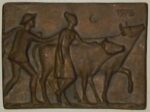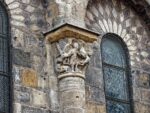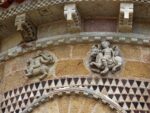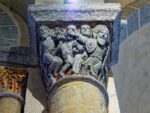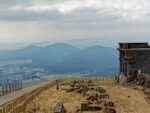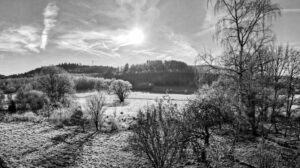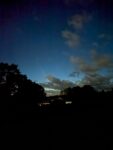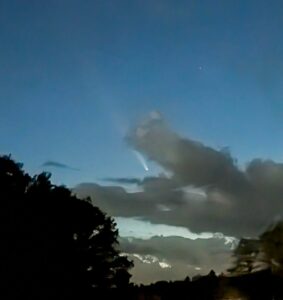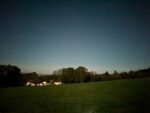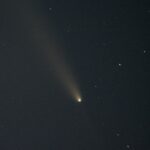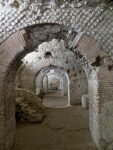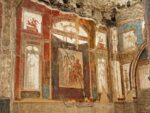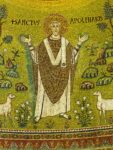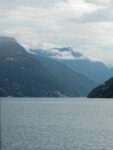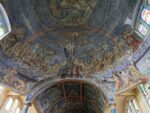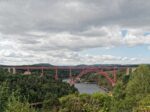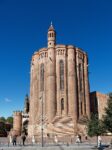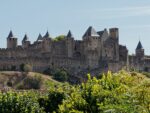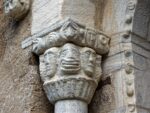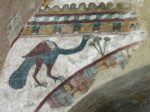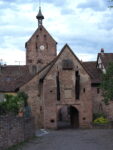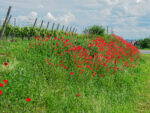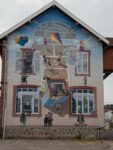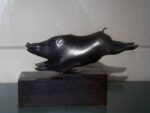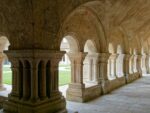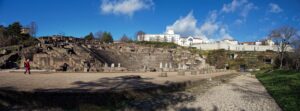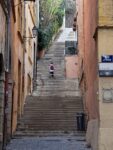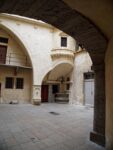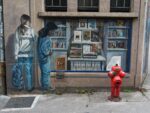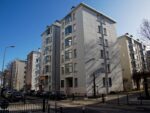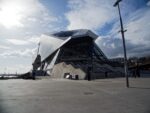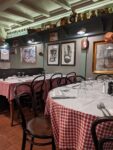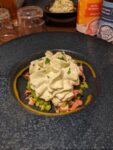To download a printable PDF version (no pictures)
click on this link E2E2023no2.pdf (eight A4 pages)
And few photographs of
Boppard, the Rhine, Schloss Stolzenfels, and other castles and the
Chagall stained-glass windows at St Stephan’s Church, Mainz
On evenings in our tranquil French village, we watch a lot of crime dramas. Our images of the deprived suburbs of Paris come from dramas like Engrenages (or Spiral), with their desolate backgrounds to the crimes tackled by Captain Laure Berthaud, Gilou, Tintin et al. We were on holiday in Koblenz (more about that later) at the end of June when the rioting broke out across towns and cities of France following the killing of seventeen year old Nahel Merzouk by a traffic police officer. So we did not see the TV images of Nanterre, to the west of Paris, but could picture the scenes of anger and violence.
At a distance, we read about the burning of cars and attacks on government buildings spreading to other towns and cities in France, the closest to Entre-deux-Eaux being in Strasbourg and Colmar, though we later learned that there had been a few cars burned in Saint Dié too, as young people (mainly of North African descent) showed their anger against police and government.
Earlier in the month we had met up in the centre of Strasbourg for a peaceful lunch by the canal with friends who live outside the town. After the events in Paris, their friend who lives near the cathedral rang to warn them not to come back into town as she had been so frightened during a night of rioting, close to all the explosions of firecrackers, tear gas grenades and shouting. And a shoe shop owner described how she had managed to close the shop and get the protective grilles down in time, although tear gas came in round the door and filled the shop, but she could not leave because of the rioting, so had to take refuge in the cellar, sealing its door against the tear gas. Other shops had their windows broken and goods pillaged and there were fires set alight.
When we returned to Entre-deux-Eaux from Koblenz, we did not hear much horror in the village over the killing of a teenager by police. He, after all, was from the feared banlieux or suburbs, whose youngsters of North African descent are perceived as a constant threat to civilised society. Previous violence and destruction on the streets of Paris and other towns by the Gilets Jaunes pension protestors, who seem to be mainly white, while deplored, had not created the same level of aversion and fear.
Local sympathy was not with the youths of the banlieux but rather with the mayor of L’Hay les Roses, whose house and family in the southern suburbs of Paris were attacked by protestors with a burning car. People throughout the country were encouraged to show their support for him by assembling peacefully at midday at their town halls. On her way to the nearby pharmacy and post office in Saulcy, Helen saw about twenty people gathered around their mayor in his sash on the steps of the mairie there, while a hundred were reported to have gathered in Saint Dié. Far more money came flooding in to support the mayor of L’Hay les Roses, than did in support of the bereaved family of Nahel Merzouk. So much for Liberte, Egalite, Fraternite. Helen remains more troubled by the counter-productive destruction of libraries and schools than of parked cars.
The situation continued to simmer. Here there have been minor deterrents to village rioting and rampaging. When John went to get petrol for the car and to fill up a can for the ride-on lawn mower, a prefectural notice on the fuel pump forbade the filling of cans (potentially for Molotov cocktails?) Also we could not buy private fireworks for Bastille Day (though we do in fact possess some elderly bangers). Because of the sécheresse or drought, there was also another prefectural order forbidding firework celebrations where forests were within 200m. Would our village celebrations on the evening of 13 July be modified?
A couple of weeks before Nahel’s killing you would have seen a very different image of French life if you had investigated the sounds of mirth and merriment emanating from a nearby copse encircling a pond. No, it was not the day of a teddy bears’ picnic, but was the day the pensioners of Sainte Marguerite have their annual barbecue. It is a few years since we have been to one of these bucolic feasts, and everyone was looking a bit more battered by life. The former club president, amiably clutching his glass of sangria, has retired (but was toasted for continuing to lend his fishing pond for the feasting), the new president had both his knees bandaged, the sporty cyclist was on crutches after a hip replacement, and the elegant 86 year old at our table was knocking back a small heart-shaped pill, one of her ten daily regime.
The men in aprons masterminding the BBQs were a new generation of cooks, but there were still a couple of the founding members of the group serving the food. The impromptu choir serenading the former president were old faithfuls, but the comedian was a more recent vintage (though we still failed to understand the punchlines).  The tent was larger than the old one, which was just as well as there must have been fifteen or so tables of 8-10 merrymakers. Its shade as welcome, but it was not challenged by rain this year. The leisurely lunch lasted about five hours.
The tent was larger than the old one, which was just as well as there must have been fifteen or so tables of 8-10 merrymakers. Its shade as welcome, but it was not challenged by rain this year. The leisurely lunch lasted about five hours.
People had already bagged their seats and some were queuing for their glass of sangria when we arrived, but members of the games and the brain-teaser groups shuffled along the hard benches to make room for us, then found an extra plastic chair for John to preside at the head of the table. He had to take care not to tip back on the uneven ground and join the fish in the pond.
 One of the new chefs, with an unreal looking tan, confided that he had personally made the pâté which would be served first, with salad. We had all brought our own plates, cutlery, glasses, water, wine and coffee, so set them out in readiness. As we had only recently returned from England, we fielded the usual questions about the coronation and Queen Camilla, before agreeing that the pâté was indeed very peppery.
One of the new chefs, with an unreal looking tan, confided that he had personally made the pâté which would be served first, with salad. We had all brought our own plates, cutlery, glasses, water, wine and coffee, so set them out in readiness. As we had only recently returned from England, we fielded the usual questions about the coronation and Queen Camilla, before agreeing that the pâté was indeed very peppery.
The BBQ pork, when it appeared after the sangria and nibbles and then pâté, was perfectly cooked, and served with potato salad and grated carrot. Large boudins blancs (white sausages) appeared next. After an interval, during which John showed our companions photos of the kestrel chicks on our windowsill following a query, slices of pork belly bacon were brought round, followed by large chunks of Brie and baguette. Things went quiet after that, so people started sharing the coffee they had brought. Then a car made its way cautiously on the narrow track around the pond bearing the desserts – the îles flottantes would never have withstood the heat if they had sat around while we ate our way through the previous spaced-out courses.
Age, however, had caught up with the pensioners at our table, and we were all (except John in his chair) finding the wooden benches extremely hard. So after the new president had circulated with his unlabelled bottle of spirits (probably an overproof pear or plum liqueur, drunk neat by the men and drizzled over a sugar lump by the women), our table started packing away their plates, cutlery and glasses and making their farewells. So we are not sure when the revelry finally ended at other tables.
There have also been the annual events, which we have written about before, like the Entre-deux-Eaux flea market on the football pitch at the beginning of June, and the meal and amateur drama production in Saulxures village in February. “Oui”, the drama at the latter was about the frustrations of a wedding planner and a young engaged couple, and was performed after the cast had brought round large plates of food to the audience (instead of leaving them to queue up as in previous years).
A novelty this year in February was the Chorale and Karaoke in the village hall. Unlike the last concert in the village hall, this one was packed (was it the lure of karaoke?) The Chorale opened with gospel songs in English, which sound rather different with no “h”s pronounced and “th”s transformed to “z”s as in cartoons of the French. One singer in the back row was particularly expressive, swaying and waving his wine glass. But there was also a very good young female soloist. In the interval Helen was introduced to one of the singers who was keen to have some English conversation practice (her reading skills are very good, but speaking is more difficult – we have included practice pronouncing “h”s and “th”s during a few afternoons a month). Helen left before the second half began, so cannot report on village karaoke talent.
Our neighbour, Daniele, had accompanied Helen to the concert, as a diversion before her forthcoming shoulder operation. Unfortunately the unexpectedly large audience may have been the source of the Covid which then kept her isolated in her hospital room, unable to receive visitors or leave. Helen saw her husband on the road one afternoon, and asked how she was. He was very perturbed as he had been looking everywhere for her missing cherished cat; he dared not tell his wife, as their previous cat had been run over last time when she was away convalescing from the operation on her other shoulder. It was a great relief to learn next day that he had eventually heard a famished miaowing in their cellar (where he had already looked). Soon after that, Helen and another friend drove over to Baccarat to see Daniele in her convalescent home, the grandly named Chateau Baccarat, where an entertainer was strolling the corridors playing an accordion. Daniele had acquired the nickname la marcheuse, as, being the most (or possibly only) mobile resident, she would walk several times round the grounds each day. We admired the grounds as we joined her for a circuit.
It was around this time in mid-March that our thoughts turned to the garden and we discovered that the floor of the small potting area inside, at the back of the second barn, was covered in white polystyrene granules. The lerots (dormice) had been spending the winter months tunnelling through the polystyrene insulation above the plasterboard ceiling and it was dropping down between the unplastered board edges. So John took down the plasterboard, and put down little plastic bags of pink rodenticide pellets both in the potting area and nearby boiler room (where the pests had nibbled the glass fibre in the casing). Helen swept the shelves clean (taking the opportunity to throw out quite a lot of accumulated containers), and the industrial vacuum cleaner gathered a huge quantity of polystyrene granules. It was gratifying to see the bags of pink grain torn open, pellets scattered, and later to discover corpses.
On the more pleasant subject of human rather than rodent nibbling, one March day we decided to try a newish restaurant, Le Valtrivin in Hachimette, Alsace. Its website explains that its name is a contraction of Valeria, Tristan and Vin (or wine) and that the chef Valeria is of Russian origin, while Tristan is an experienced sommelier. John was intrigued by their huge wine list – 54 pages of wines. 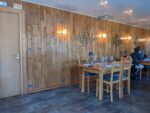 This seemed at odds with the dated, bare dining room in a modest hotel and bar, which the couple were running unaided. It still had the feel of those cheap French hotels where back in the seventies and eighties one would turn up unannounced around 4 o’clock to get a room and meal on a first-come, first-served basis. Valeria’s food, as in the old days, was well presented, though not very exciting. We only wanted a glass of wine each but there was no wine-by-the-glass in the list to choose from. We asked, and Tristan was prepared to open any of his many bottles, though without quoting a price. The local Ammerschwihr bottle of pinot gris he opened for our two glasses was good as was a bottle of red he opened for a single glass (and both were reasonable when the bill came) and the remaining wine in the bottles was offered to another table. Perhaps his bottles were all discounted ends of series (the couple had previously run TrioVino, a wine-tasting for tourists enterprise in Lyon).
This seemed at odds with the dated, bare dining room in a modest hotel and bar, which the couple were running unaided. It still had the feel of those cheap French hotels where back in the seventies and eighties one would turn up unannounced around 4 o’clock to get a room and meal on a first-come, first-served basis. Valeria’s food, as in the old days, was well presented, though not very exciting. We only wanted a glass of wine each but there was no wine-by-the-glass in the list to choose from. We asked, and Tristan was prepared to open any of his many bottles, though without quoting a price. The local Ammerschwihr bottle of pinot gris he opened for our two glasses was good as was a bottle of red he opened for a single glass (and both were reasonable when the bill came) and the remaining wine in the bottles was offered to another table. Perhaps his bottles were all discounted ends of series (the couple had previously run TrioVino, a wine-tasting for tourists enterprise in Lyon).
It was while we were relaxing over a meal at our favourite restaurant, L’Imprimerie (which alas has increased its prices considerably) that we began to discuss how to celebrate Helen’s 80th birthday. Helen had always said she didn’t think the excitement of 80th birthday parties was a good idea, as various friends of her mother had died shortly after their celebrations. However, it felt a long time since we had seen many of our friends, what with Covid and other health problems, so we decided not to be superstitious and began to make plans for a “do” in mid-May.
As a result of lots of e-mails and our preparatory trip to Letchworth over Easter, on 12 May the Train Gang and partners met up for the first time in several years, and in the evening joined family and helpers for tasty tapas-style dishes and interesting-looking cocktails at a restaurant in Baldock. The next day we were delighted by how many people made it to Letchworth for the party, despite rail strikes and miserable weather. Those who braved the garden was grateful that Alistair ignored our firm instructions not to get logs or risk lighting a fire in one of the gazebos! Indoors, John, Leila and Ann continued to be busy in the kitchen, while the rest of us gossiped over food and drinks and Toby and Derek kept the younger guests amused with games. Bruce wandered round taking photos of everyone, though sadly Helen’s cousin and her husband arrived after the family photo was organised. The next day was lovely and sunny, as the gazebos were taken down and the workers relaxed under the parasol eating and drinking left-overs. The following days were also warm and sunny – and would have been ideal for an outdoor party. An unexpected trip to see the musical Hamilton in London was Toby and Rachel’s birthday gift to Helen, who also took the opportunity to catch up with some London friends who hadn’t made it to the party. We had well and truly celebrated the milestone.

The male brings a vole
There have been births as well as birthdays to celebrate. A lot of you have been following the return of the kestrels at the end of January (several months earlier than previous years) to our attic windowsill for the third year running. If you missed that, you can catch up on the 2023 kestrels website. By the end of April, six kestrel eggs had been laid, and while we were in Letchworth in May, we were able to follow their progress, thanks to the new cameras John had hurriedly installed after the earlier than expected return and he was able to update the website and YouTube feeds. We were glad of that, as all six eggs hatched at the end of May, just a few days before our return to Entre-deux-Eaux. We were then able to watch their growth as the males brought mice and lizards for the female to feed to them until they were ready to fledge. This occurred at the end of June when they were 32-35 days old, which is later than the usually reported 28-30 days, possibly due to the extreme heat. Sadly their departure was again while we were away. So, alas, we were to return to an empty nest – or windowsill. But there have been occasional return visits of the juveniles or the parents to the nest in early July.
After a while back here, we began to feel restless. The river Rhine between Cologne and Mainz is promoted as “the romantic Rhine” with its castles, gorges, vineyards and Lorelei legends. Phrases like “melodramatic panorama of nature” and “backdrop for the portrayal of human passions and destinies “ abound, along with mention of the music of Wagner, the literature of Goethe and Heine and the paintings of Turner. The area is also a World Heritage Site. So during a very hot spell of weather here at the end of June, the idea of spending a few days drifting up and down that stretch of the Rhine on an old paddle steamer or on local ferries, was appealing. We are only an hour’s drive from the Rhine, and it is easy to cross into Germany from here. We decided to head north and base ourselves in Koblenz (four hours drive from E2E) after stopping overnight on the Sunday in Mainz (which we had to remember to call Mayence to our French neighbours) to see the cathedral, Gutenberg museum, Chagall windows, and meet up for dinner with a friend, Heide, who lives in Frankfurt am Main.

Chagall windows, Mainz
Our cheap hotel in Mainz was on the far side of the railway line, and on that very hot day we slogged past the main railway station four times in and out of the city; it seethed with travellers, local buses, police and drinkers. It was the weekend of Mainz’s Johannisnacht festival (which we did not know about until Heide mentioned it when we suggested meeting up), so we had to inch through the big squares near the cathedral which were packed with people celebrating Johannes Gutenberg in the hot sunshine. Few people were honouring his achievements in the rather disappointing Gutenberg museum, where there were special demonstrations on a replica printing press. Perhaps his legacy was being toasted in beer, lurid ice cream, candy floss and curry wurst, among the bands, stilt-walkers and fairground rides, which lapped up to the cathedral. We may have been jaded, as we found the interior of the cathedral lofty, dusty and soulless – like a railway terminal. However, after a further hot walk to a hill (where better to place a church), we were revived by the hushed and prayerful St Stephan’s gothic church with its dramatic blue windows by Chagall. Chagall, who was Jewish, made them at the end of his life as an acknowledgement of the need for reconciliation, and they were completed after his death by others. In the background musicians tuned up, people gathered in the cloisters, and a concert began. Sadly Heide was unable to join us in the evening because of the heat.
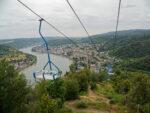
Boppard Sesselbahn chair lift
Next day we drove slowly along the river and through hilly vineyards to Koblenz, During our four days we were to see the Romantic Rhine by car, boat, train, cable car, chair lift and on foot.  But, for us, its mystique seems to have vanished under the pressures of mass tourism. We saw none of the hazy scenes that Turner painted nor sensed the dramas, chivalry or warfare of the ruined castles. We both felt that our most enjoyable view was during an afternoon ride on what felt like a family-run ski chair lift from the valley to the surrounding hills followed by a short walk through the woods to a café with a loud, bossy waitress; there we relaxed over coffees and enjoyed the view down over a huge bend in the Rhine near the small town of Boppard.
But, for us, its mystique seems to have vanished under the pressures of mass tourism. We saw none of the hazy scenes that Turner painted nor sensed the dramas, chivalry or warfare of the ruined castles. We both felt that our most enjoyable view was during an afternoon ride on what felt like a family-run ski chair lift from the valley to the surrounding hills followed by a short walk through the woods to a café with a loud, bossy waitress; there we relaxed over coffees and enjoyed the view down over a huge bend in the Rhine near the small town of Boppard.

Rhine ferry
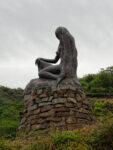 That morning had seen us perched on rocks at the feet of the Loreley (or Lorelei) statue, unmoved by her allure or the clouds of gnats, but more fascinated by the series of very long, fast-moving freight trains on tracks on both sides of the river as they plunged into or emerged from the ornate railway tunnels through the gorge. We also watched goods moving along the river more slowly in barges, including a laden scrap metal one. We (and the Loreley) were passed by the regular tourist boats, including the Goethe paddle steamer which we had travelled on the day before. (The young waiter on the Goethe had been unmoved by the series of castles we were passing – an every day background to his work – he just wanted to discuss John’s Olympus camera as he hoped one day he might be able to afford something similar, though it would cost over a month’s wages). We never established the priority rules for barges and boats going up and down the Rhine and the frequent nippy little car ferries crossing from bank to bank (there being no bridges across the Rhine between the outskirts of Mainz and Koblenz). For us, crossing on the busy little ferries was more entertaining than lazing on the pleasure boats (and we had to do several as the valley road on the eastern side had sections closed for repairs).
That morning had seen us perched on rocks at the feet of the Loreley (or Lorelei) statue, unmoved by her allure or the clouds of gnats, but more fascinated by the series of very long, fast-moving freight trains on tracks on both sides of the river as they plunged into or emerged from the ornate railway tunnels through the gorge. We also watched goods moving along the river more slowly in barges, including a laden scrap metal one. We (and the Loreley) were passed by the regular tourist boats, including the Goethe paddle steamer which we had travelled on the day before. (The young waiter on the Goethe had been unmoved by the series of castles we were passing – an every day background to his work – he just wanted to discuss John’s Olympus camera as he hoped one day he might be able to afford something similar, though it would cost over a month’s wages). We never established the priority rules for barges and boats going up and down the Rhine and the frequent nippy little car ferries crossing from bank to bank (there being no bridges across the Rhine between the outskirts of Mainz and Koblenz). For us, crossing on the busy little ferries was more entertaining than lazing on the pleasure boats (and we had to do several as the valley road on the eastern side had sections closed for repairs).
As well as boat and car trips, we travelled by train along the Rhine back to Koblenz, having taken the paddle steamer journey one way. We also joined young people returning home from school or college on the “picturesque” Hunsruck Railway from Boppard to Emmelhausen in the hills. It is the steepest adhesion railway in western Germany, climbing 336 metres in eight kilometres, through five tunnels and over two viaducts. But because of the forest on both sides, the promoted picturesque views were much more limited (apart from the last minutes of the return descent) than those from our single track railway over the Vosges from Saint Dié to Strasbourg.
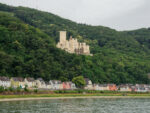
Schloss Stolzenfels
As for castles, we looked at various silhouettes from a distance, strolled round the outside of the Sankt Goar ruins (as it was closed on Mondays), and, after slogging up its long and winding drive, joined a guided tour of the interior of the Schloss Stolzenfels summer residence of the Prussian Royal family. We must have helped to polish the Stolzenfels wooden floors as we shuffled round wearing enormous slippers over our outdoor shoes. Next day it would be closed for a film crew. We also spent time looking round the huge Ehrenbreitstein fort, one of several surrounding Koblenz, which had been rebuilt in 1801 after the French revolutionary army destroyed the old castle/fortress (we realised again how little we know of European history and the wars between the various states and provinces, which bear little resemblance to modern-day Europe). The journey to and from it was by cable car, with great views as it crossed over the Rhine and, on the return trip, of the whole of Koblenz (but we still thought the chair lift at Boppard was more intimate and dramatic).
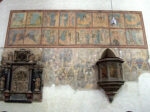
Saint Alexius
We also visited quite a few churches and for the first time saw a large fresco of scenes from the life of Saint Alexius (the one who lived under the staircase in his parents house, unbeknown to them, doing good works, and whose name we first encountered in a little auberge restaurant St Alexis and chapel in Alsace). The fresco was in the Carmelite church in Boppard, which also had some magnificently carved choir stalls. In the nearby church of Saint Severus there were ceiling paintings as well as vibrant modern stained glass windows by a local artist.
Every morning started with a filling German breakfast at our Koblenz hotel (again close to the railway station and overlooking the bus station), though we were amazed by how much some of the portlier German guests could stuff in. Breakfast lasted us all day and by the evening we were usually too footsore to want to go far afield. So, apart from a good meze bar in the centre, the other evenings we ate at nearby at Greek, Italian and Croatian restaurants, at all of which the portions were still pretty large for those of us brought up on strict instructions to eat everything on your plate. The Croatian restaurant was especially good, and the chef even emerged to apologise to John as his sea bass, being rather large, was taking a long time to cook; it was skilfully filleted at the table and John happily ate it all. At the end a small glass of plum and pear liqueur unexpectedly appeared with the bill.
On the drive back to Entre-deux-Eaux on the Friday we stopped in Worms to see the Romanesque red stone cathedral, the museum’s Martin Luther room and the old Jewish cemetery. Once over the NE border of France (where the narrow, wooded German road turns into a wide French motorway), the heavens opened and rain pelted down. Helen inadvertently drove onto the new Strasbourg outer tolled bypass, guided by Waze (as she points out, that choice was not there last time we drove that way), but at least it avoided the busy inner bypass at rush hour.
Next day, back home, we agreed that we felt underwhelmed by the glories of the Romantic Rhine. Is increasing age (Helen is now rather self-conscious about that) responsible for an increasing loss of wonder? In Paris the funeral of Nahel Merzouk was held, and rioting continued at night.
During July we have settled back into the quiet of Entre-deux-Eaux and picked quantities of raspberries, loganberries, tayberries, blueberries and wild strawberries which had ripened in the heat while we were away. The vegetable patch, unlike the fruit cage, is sadly bare this year, with three beetroots, three courgettes, two squash and some straggling broad beans the only survivors of our various absences during dry weather conditions. It has continued to be hot here, with occasional heavy rain and storms, though it has been worse on the plains of Strasbourg, where our friends report up to 37°C in the shade. But still, fortunately, not as bad as the extreme temperatures that are being experienced by residents and holiday makers in southern Europe.
And, given the riots, were there any Bastille Day fireworks?. Various communes especially in Ile-de-France and le Nord cancelled their 14 July fireworks, but Paris went ahead with theirs around the Eiffel Tower. Next day newspapers triumphantly reported that in Paris and its suburbs there were only 62 fires (a drop on last year of 70%) and 53 arrests (an 80% drop) and that throughout France that night only 255 vehicle were set fire to (as opposed to 423 last year). Moreover only 7 police, gendarmes and firemen were injured compared to 21 in 2022.
Entre-deux-Eaux has its feasting, fair and fireworks on the evening of 13 July. At the end of a hot day we felt a bit apathetic about walking down to the village and standing around for ages, so stayed at home with the fan on, watching TV. But when we heard the first bangs, we went out on our balcony and saw a short, defiant display above the trees, which looked as if all the different fireworks had been set off simultaneously in one glorious multicoloured outburst. Next evening on the fête nationale itself, we responded to more bangs around 11pm by dashing again onto the balcony. In the opposite direction from the previous evening we could see Saint Leonard’s rather sedate sequence of fireworks. Entre-deux-Eaux’s, however brief, had definitely been more spectacular. From male voices down our road came a rather tuneless rendering of the Marseillaise.

a juvenile returns


